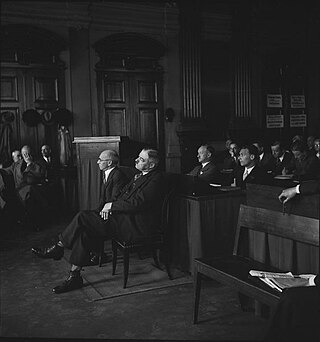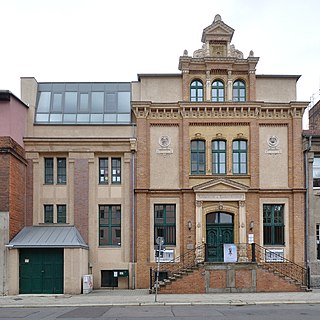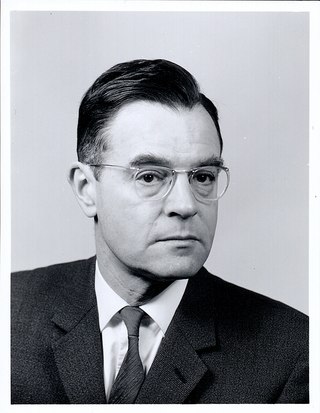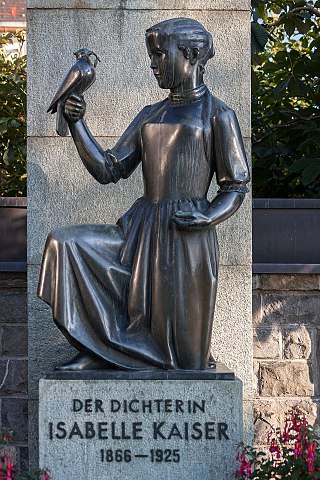Related Research Articles

Richard Robert Ernst was a Swiss physical chemist and Nobel laureate.

Paul Hermann Scherrer was a Swiss physicist. Born in St. Gallen, Switzerland, he studied at Göttingen, Germany, before becoming a lecturer there. Later, Scherrer became head of the Department of Physics at ETH Zurich.

The Berne Trial or Bern Trial was a famous court case in Bern, Switzerland which took place between 1933 and 1935. Two organisations, the Swiss Federation of Jewish Communities and the Bernese Jewish Community sued the far-right Swiss National Front for distributing anti-Jewish propaganda. The trial focussed on the Front's use of the fraudulent antisemitic text, The Protocols of the Elders of Zion. Ultimately decided in favour of the plaintiffs, the Front was ordered to pay a symbolic fine and court costs. However, the trial became significant both for the international coverage and also for the extensive evidence presented, demonstrating the falsehoods contained in The Protocols.

Peter Stamm is a Swiss writer. His prize-winning books have been translated into more than thirty languages. For his entire body of work and his accomplishments in fiction, he was short-listed for the International Booker Prize in 2013, and in 2014 he won the prestigious Friedrich Hölderlin Prize.

A Kunstgewerbeschule was a type of vocational arts school that existed in German-speaking countries from the mid-19th century. The term Werkkunstschule was also used for these schools. From the 1920s and after World War II, most of them either merged into universities or closed, although some continued until the 1970s.
Konstantinos "Kostas" Koufogiorgos is a Greek-German political cartoonist and painter.

Ambrosius Paul Speiser was a Swiss engineer and scientist. He led the development of the first Swiss computer.
Hans Tolford was an Austrian painter, poet, photographer, filmmaker, author and illustrator.

Daniele Ganser is a Swiss author and conspiracy theorist. He is best known for his 2005 book NATO's Secret Armies.

Zurich University of the Arts has approximately 2,500 students, which makes it the largest arts university in Switzerland. The university was established in 2007, following the merger between Zurich's School of Art and Design (HGKZ) and the School of Music, Drama, and Dance (HMT). ZHdK is one of four universities affiliated with Zürcher Fachhochschule.

Jonas Lüscher is a Swiss-German writer and essayist.

The Institute for the History and Theory of Architecture is a teaching and research institute at the Department of Architecture of ETH Zurich, situated on the ETH Zurich’s Hönggerberg Campus site.

Peter Schweri was a Swiss artist, painter, illustrator, photographer and from 2008 on a music composer. He is a representative of the "Zürich constructivism".

Hans von Matt was a Swiss painter and sculptor. He was at the heart of an artists' network, known to some contemporaries as much for their fun-loving lifestyle as for serious artistic endeavour. He emerged as a writer on the arts and a "culture politician". He was born and lived in Central Switzerland.

Hans Gugelot was an Indonesian-born, German engineer and industrial designer known for his modernist consumer products.

Gerold Meyer von Knonau was a Swiss geographer and historian whose most enduring contribution to scholarship may well have been his pioneering work between 1837 and 1858 as cantonal archivist for Zürich and the surrounding region.
Robert Schwarzenbach & Co was a Swiss American textile manufacturing concern. Founded in 1829, the concern was active in silk and jacquard manufacturing. In 1928, Schwarzenbach was the largest textile company in the world exceeding 28,000 employees worldwide with a net turnover of 267 million Swiss francs. The majority of sales were generated in the United States through the subsidiary Schwarzenbach, Huber & Co based in New York City. In 1981, all manufacturing activities were seized and the concern was converted into a private real estate and investment vehicle currently still owned and managed by the Schwarzenbach family.
Ruth Schweikert was a Swiss writer.
Cédric Weidmann is a Swiss writer, philologist and literary promoter. He holds a doctorate from the ETH Zurich (2022).
References
- 1 2 Claudia Bieler (10 August 2016). "Steger, Hans-Ulrich". Dictionnaire historique de la Suisse. Retrieved 18 May 2018.
- 1 2 Marc Tribelhorn (26 June 2016). "Der unerbittliche Strich". Mit seinen Karikaturen hielt er der Politik während Jahrzehnten den Spiegel vor und wurde so zum Chronisten des Zeitgeistes. Eine Annäherung an H. U. Steger, der 93-jährig verstorben ist. Neue Zürcher Zeitung . Retrieved 18 May 2018.
- 1 2 3 4 5 6 "Steger, Hans U." Archiv für Zeitgeschichte. ETH Zurich . Retrieved 18 May 2018.
- ↑ Serge Hediger; Martin Knoepfel (28 June 2016). "Eine kritische Stimme ist verstummt". Hans Ulrich Steger ist tot. Der bekannte Zeichner mit Heimatort Lichtensteig veröffentlichte über 50 Jahre lang politische Karikaturen, unter anderem auch für den «Nebelspalter» und die «Weltwoche». St.Galler Tagblatt . Retrieved 18 May 2018.
- ↑ "Zivilstandsnachrichten 2016, Todesfälle" (PDF). Lorzengezwitscher. Kanton Zürich, Ortsvertretung Maschwanden. February 2017. Retrieved 19 May 2018.
- ↑ "Hans Ulrich Steger aus Maschwanden - Todesanzeige". Todesanzeigen Online, Bergdietikon. 25 June 2016. Retrieved 19 May 2018.